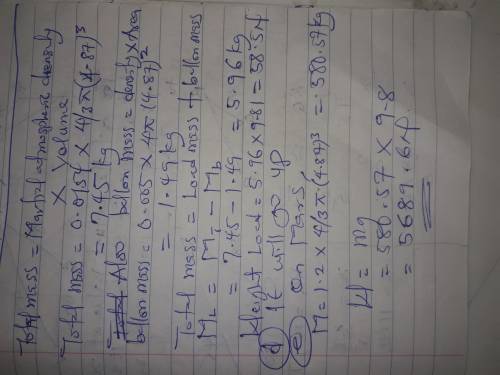
Physics, 21.04.2020 04:40, alex12everett
It has been proposed that we could explore Mars using inflated balloons to hover just above the surface. The buoyancy of the atmosphere would keep the balloon aloft. The density of the Martian atmosphere is 0.0154kgm30.0154kgm3(although this varies with temperature). Suppose we construct these balloons of a thin but tough plastic having a density such that each square meter has a mass of 5.00 g. We inflate them with a very light gas whose mass we can ignore.
(a) What should be the radius and mass of these balloons so they just hover above the surface of Mars?
(b) If we released one of the balloons from part (a) on earth, where the atmospheric density is 1.20kgm31.20kgm 3, what would be its initial acceleration assuming it was the same size as on Mars? Would it go up or down?
(c) If on Mars these balloons have five times the radius found in part (a), how heavy an instrument package could they carry?
(d) Would it go up or down?
(e) If on Mars these balloons have five times the radius found in part A, how heavy an instrument package could they carry?

Answers: 3
Other questions on the subject: Physics

Physics, 22.06.2019 09:40, zackarygonzalez1028
Which is special about a dc circuit ? a. it has both series and parallel components b. it has only series or only parallel components c. charge moves in a single direction d. charge moves back and forth quickly
Answers: 3

Physics, 22.06.2019 11:30, emily965692
Where is the potential energy throughout the loading, cocking, and releasing of the trebuchet?
Answers: 2

Physics, 23.06.2019 01:30, chafinh1811
Six pendulums of mass mand length las shown are released from rest at the same angle theta from vertical. rank the pendulums according to the numberof complete cycles of motion each pendulum goes through perminute. a. l= 1m m=2kg b. l= 4m m=1 kg c. l= 2 m m= 2 kg d. l= 1 m m= 4 kg e. l= 2 m m = 4 kg f. l= 4m m = 4kg
Answers: 3

Physics, 23.06.2019 03:40, hernsl0263
Anumber of conditions are required for a population to be in hardy-weinberg equilibrium. which of the following are correct descriptions of the conditions that must be met? check all that apply. a. no mutations b. random mating c. small population d. migration or gene flow e. occurrence of mutations f. no natural selection
Answers: 1
Do you know the correct answer?
It has been proposed that we could explore Mars using inflated balloons to hover just above the surf...
Questions in other subjects:


Social Studies, 30.01.2020 06:56


Social Studies, 30.01.2020 06:56






Mathematics, 30.01.2020 06:56









